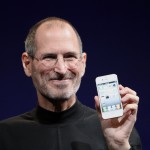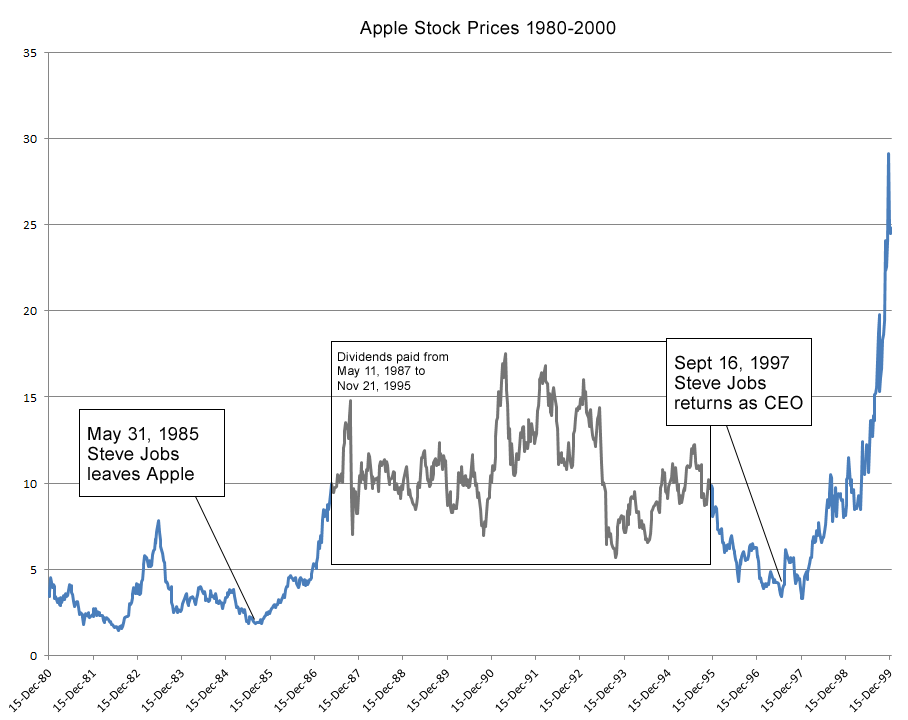Apple: The Day The Music Died

When Apple (AAPL) launched the Mac in 1984 I was one of the first to by the Inside Mac developer series and started leveraging my skills as an Apple developer. I’ve been a fan ever since that time. In the beginning, it was all about the Steves. Steve Jobs and Steve Wozniak. You couldn’t really determine who was key to Apple’s creative direction. But it soon became clear that Steve Jobs was the wizard behind the curtains.
In this article, i’d like to present a mostly qualitative argument that without Steve Jobs there is no Apple. Instead you are left with a boring company that hit its maturity prematurely and will be the subject of plenty of debates, internal and external, on how it should be operated. For example, due to its recent momentum from the sales of iPhone and iPad sales, Apple recently (August 2012) hit a market capitalization of $623.5 billion making it the largest company in the world against this measure surpassing Microsoft (MSFT).
I’ll argue that the Apple that everyone knows and loves is a disruptive company that destroyed existing markets and created new markets. And i’ll suggest that Apple today is a sustainable company that is sadly overpriced and will eventually find its level.
On October 5, 2011, Steve Jobs passed away and will be sorely missed. Not only by friends and family but all of the Apple fans who fell in love with the dream. The picture of the future that he painted with his products. Since his passing, Apple has made one misstep after another producing mostly derivative products such as smaller iPads and minor upgrades to the iPhone.
Fans who are still in denial will point to the success of the iPhone 5 and current revenue but to quote Roger Kay of Endpoint Technologies, “Apple can continue to fly along on the fumes of the Steve Jobs-era for quite a while.”
One of the most interesting aspects of the Jobs-effect is how Apple behaved when he was at the helm compared to the other CEOs both during the dark period when Jobs left to create Next Computer and since his passing with Tim Cook as the CEO.
The Decline from 1986 to 1997
After Steve Jobs left Apple as the result of a dispute between him and John Sculley (then CEO of Apple), things changed. For a while, Apple coasted on the success of the Macintosh, a Steve Jobs product, but the success simply couldn’t last without the creative follow-through. For the most part products produced during this time were disasters including the Newton (remember that one?) and Pink; an attempt to upgrade the Mac OS which also failed miserably.
When the board had enough of Gil Amelio’s performance, they got rid of him and put Steve Jobs in-place as the iCEO (interrim CEO). Gil had recently purchased Next Computer and the NextSTEP OS which was to become OS X. Turns out this was the last and the most significant thing he did.
The Golden Years from 1998 to 2011
With the launch of the iMac, the iPod, the iTunes music store, the iPhone and the iPad, Apple stock soared. Even the mistakes were not just forgiven, they were completely dismissed. It seemed to me that Jobs would simply pretend they didn’t happen and we all agreed. The simple truth was that Apple produced amazing products. They were functional, innovative and simply beautiful.
The Two Faces of Apple: Disruptive Apple
Apple computer was a disruptive company under Steve Jobs. They produced new products that created new markets, destroyed the markets for existing products and innovated unlike any company to date.
While the whole personal computer industry in the 80s was disruptive, by the time Steve Jobs left it was starting to become main-stream. Throughout the majority of the 90s, Apple floundered looking for sustainable improvement to existing products and while they tried to launch a disruptive product or two (remember the Newton?) they did it in a timid almost apologetic way. When Jobs returned, the first thing he did was turn the company upside down. He fixed the lagging Macintosh product line with a new OS, new look and feel and that special brand of Steve Jobs “cool” that was missing with Sculley, Spindler and Amelio.
Then he set out to create products and markets that hadn’t been done before, using each one as a stepping stone for the next. No roadmaps existed for this journey.
When Apple created the iPod, nothing like it really existed. We had MP3 players but the iPod wasn’t meant to be an MP3 player. The MP3 player was just another take on the CD and the Cassette player. The only thing that was changed was the medium and the number of supported songs.
The iPod was different. It married the computer and the music player allowing you to manage your music, create playlists and otherwise enhance your experience. Add in the other cool aspects of the iPod Touch for example and now its a game changer.
Then, Jobs completely turned the music business upside down with the iTunes music store. All of a sudden, the CD music industry is in a decline that one company created single-handedly. And before you say anything, I’m intentionally ignoring Napster and some of the other less successful attempts prior to the iPod in this discussion.
So after restructuring the music industry, Apple decides they need to help the convergance of technologies and turn an iPod into an iPhone. This didn’t set well with most of the phone manufacturers which for most companies would have been the end of the project but not for Jobs. He decided that if the phone companies wouldn’t do it, then Apple would build their own phone. In 2007, Apple under Steve Jobs vision, created the smartphone, starting a path that would pretty much make feature phones obsolete and all but destroy Research in Motion (BBRY).
The Two Faces of Apple Computer: Sustainable Apple
For the time that Steve wasn’t at Apple, the company was run in exactly the way you would expect a public company to be run. The performance of existing products was analyzed and the products were enhanced or killed accordingly. New products were determined by committee, risk was estimated and weighted against return and the projects lived or died accordingly.
Tim Cook is very qualified to run a large company. He has the education and the background and has been taught by the best. But he’s missing one thing that makes Apple…well, Apple. He is not disruptive. Tim will do the right thing including pay dividends when investors like David Einhorn demand it.
Tim Cook will take disruptive, market creating, innovative Apple computer and set it on a path towards calmer waters. Tim Cook will turn Apple into a model Clayton Christensen, sustainable tech company.
And thats not a bad thing but the problem with that is the current stock price has a disruptive Steve Jobs valuation. Everyone wanted a part of whatever Steve created next. You won’t get that with Tim Cook. The stock will have to find its new level as the market adjusts to the new personality of Apple computer.
I wanted to see the effect that Steve Jobs had on the stock price both while he was at Apple and during his absences and in the process noticed that the stock price distinctly shows the companies two different personalities.
Steve Jobs’ Apple acts like an innovative company focused on product development and the user experience.
The other Apple caters to investors and fills the product development void with dividends.

And the market is starting to notice. Jeff Gundlach, CEO of Doubleline Capital, lamented the lack of innovation at the new Apple asking if they were going to release a tutti-frutti iPad in different colors.

How To Trade Apple
Apple is the exact opposite of Facebook (FB). Facebook with Zuckerberg at the helm is the company investors love to hate. They don’t want to acknowledge the potential growth, simply because Zuckerberg seems to have taken the place of Bill Gates as the new head of the evil empire. This stock moves like a brick. Even good news is overshadowed by the lackluster presentation of its CEO.
Apple is in a different position. Apple has a cult-ish user-base that absolutely loves the products and to some extent is still in denial. As new derivative products are releases, you will still see pops in the stock price simply because the herds of fans will go stand in lines to be the first to get the new “Mango Orange” mini-ipad.
Wait for these pops and either short-sell the stock or buy puts on the upswing. You can also use these pops to divest of any shares you bought during Apple’s heyday.
We’ll miss you Steve Jobs.